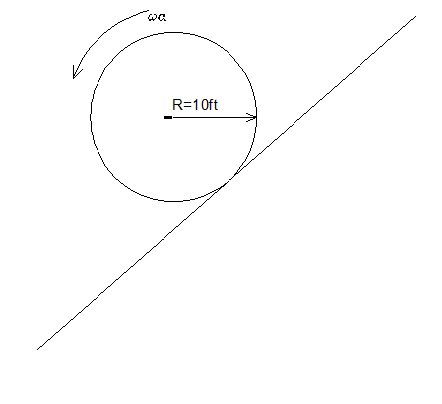 |
||||||||
 |
 |
 |
 |
|||||
 |
||||||||
 |
||||||||
 |
 |
|||||||
 |
||||||||
 |
||||||||
 |
||||||||
 |
||||||||
 |
||||||||
EXAMPLE: ROLLING CYLINDER
Consider the midplane of a homogeneous cylinder rolling down an incline. The radius of the cylinder is 10 feet. It has at the instant of the figure, an angular rotation of ω = 2(r)/(s) and an angular acceleration of α = 3(r)/(s2), both counterclockwise.
- a) Find the point in the plane where there is zero acceleration.
- b) Using only symbols and integration, compute the moment of inertia about the out of plane axis (z) axis at the point where the cylinder touches the inclined plane, if the density of the cylinder is ρ = ρ0⎛⎝1 − (r)/(2R)⎞⎠ and the length of the cylinder is T.

Solution
a) This problem can be solved using the two-dimensional acceleration equation
aQ = aP + θ̈k × rPQ − θ̇2 rPQ
The free body diagram of the figure, along with the coordinate system, is shown in Fig. 2↓.
If the origin is set to O and substituting variables yields
a0 = aC + α × rCO − ω2 rCO
aC = α × rIC = 3 k × ( − 10 j) = + 30 i
Where C is the center of the cylinder, IC is the instantaneous center and rCO is the unknown direction vector to location of zero acceleration:
0 = aO
=
+ 30 i + 3 k × rCO − 4rCO
=
+ 30 i + 3xj − 3yi − 4xi − 4yj
This equation can be decomposed into two equations, which can be solved simultaneously:
i:
+ 30 = 4x + 3y
× 4
120 = 16x + 12y
3x − 4y = 0
j:
0 = 3x − 4y
× 3
+ 0 = 9x − 12y
3⎛⎝(24)/(5)⎞⎠ − 4y = 0
120 = 25x, x = (24)/(5)
y = (18)/(5)
Replacing these values into the original position equation, the position vector is
rCO = (24)/(5) i + (18)/(5) j
